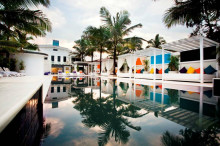 Kanyakumari
Kanyakumari
Formerly christened Cape Comorin by the British, the place derived its name from its geographical distinction as a cape. Kanyakumari, as it is known today, is a place sacred to Hindus, with two of the 51 shakthipeethas in South Asia located here at the Bhagavathy temple and Shuchindram. The most visited place now, no doubt, is the Vivekananda Rock Memorial accessible by a short boat ride from the mainland which is a spot to view the most spectacular sunrise and sunset in the country. It is believed that Swami Vivekananda visited here to take the blessings of the Kanyakumari Devi, who is considered to be the deity of sanyas. The rock is also known as Sripadaparai which bears a footprint like projection, endorsing the myth that it is the footprint of the Devi.
Kanyakumari is the land’s end, situated at the tip of the Indian peninsula at the junction of the Indian Ocean, the Arabian Sea and the Bay of Bengal. The panoramic sweep of the ocean and the sighting of three of the globe’s biggest oceans in a seamless embrace, in the distance, evoke a breathtaking sense of awe. Kanyakumari’s strategic location on the international maritime route made it the entry point of Islam and Christianity into the Indian sub continent in the early part of the Christian era. Religions like Islam, Christianity and Jainism and dynasties like the Cholas, Cheras, Pandyas and Nayaks who held sway over the place in various periods of history have created a huge wealth of architectural and literary heritage in the region. The biggest historical draw for a tourist in Kanyakumari is the Padmanabhapuram Palace, en route, which was built in 1601 AD by the then Travancore ruler and remained the seat of Travancore or Venad for two centuries. Considered one among the best ten palaces in the world, it is a massive marvel in wood with 108 rooms, at the foot of the Veli hills in the Western Ghats, flanked by river Valli on one side.
The 17th and 18th century murals, carved ceilings, underground passages and the gleaming black floors made from a unique indigenous mixture all shout its archeological value. The Kanyakumari beach is famous for the kaleidoscopic shades of its sand, which lend it a piquant touch. Seven kilometres away from Kanyakumari is Vattakkottai Fort, an 18thcentury seaside fort and a protected archeological site built in the 18th century by the Travancore king Marthanda Varma with its promenade jutting into the calm sea, which is ideal for a soothing dip. The Mathur Aqueduct built across the Pahrali river, one the longest and highest aqueducts in South Asia and Muttam, a small fishing village flanked by a sandy beach and a rocky beach on either side, housing a lighthouse are also great tourist draws. Visit the place and you will discover how Kanyakumari is a wonderful potpourri of art, history, mythology, religion, nature, and spirituality.




